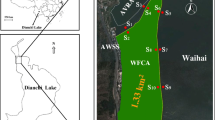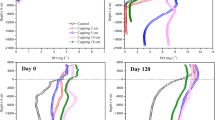Abstract
A phytoremediation project involving the large-scale cultivation of water hyacinths (Eichhornia crassipes (Mart.) Solms) was conducted in Lake Caohai (China) from May to November during 2011–2013 to remove pollutants and decrease eutrophication. Water hyacinths were cultivated in two areas of Lake Caohai, Neicaohai, and Waicaohai, which are connected and function as a relatively independent water body. The areas for macrophyte growth varied in size from 4.30 km2 in 2011 to 0.85 km2 (2012) and 1.15 km2 (2013). Compared with historical data from 2007, the concentrations of total phosphorus decreased significantly, while dissolved oxygen concentrations increased slightly. After plant cultivation in 2011, the average concentrations of total phosphorus, total dissolved phosphorus, and phosphate anions decreased from 0.54, 0.35, and 0.23 mg L−1 upstream (river estuaries) to 0.15, 0.13, and 0.08 mg L−1 downstream (Xiyuan Channel), respectively. The amount of phosphorus assimilated by the macrophytes (44.31 t) was more than 100% of the total removed phosphorus (40.93 t) from lake water when water hyacinths covered 40.9% of the area, which could indicate sedimentary phosphorus release. Our study showed the great potential of utilizing water hyacinth phytoremediation to remove phosphorus in eutrophic waters.





Similar content being viewed by others
References
APHA (1998) Standard methods for the examination of water and wastewater. American Public Health Association, Washington DC
Bao SD (2000) Soil and agriculture chemistry analysis. Agriculture Publication, Beijing (in Chinese)
Batty LC, Dolan C (2013) The potential use of phytoremediation for sites with mixed organic and inorganic contamination. Crit Rev Environ Sci Technol 3(3):217–259
Bowes MJ, Neal C, Jarvie HP, Smith JT, Davies H (2010) Predicting phosphorus concentrations in British rivers resulting from the introduction of improved phosphorus removal from sewage effluent. Sci Total Environ 408(19):4239–4250
Chapra SC, Dobson HFH (1981) Quantification of the lake trophic typologies of Naumann (surface quality) and Thienemann (oxygen) with special reference to the Greak Lakes. J Great Lakes Res 7:182–193
Chunkao K, Nimpee C, Duangmal K (2012) The King’s initiatives using water hyacinth to remove heavy metal and plant nutrients from wastewater through Bueng Makkasan in Bangkok, Thiland. Ecol Eng 39:40–52
Dove A, Chapra SC (2015) Long-term trends of nutrients and trophic response variables for the Great Lakes. Limnol Oceanogr 60:696–721
Fraser GCG, Hill MP, martin JA (2016) Economic evaluation of water loss saving due to the biological control of water hyacinth at new Year’s dam, eastern cape province, South Africa. Afr J Aquat Sci 41(2):227–234
Funari E, Testai E (2008) Human health risk assessment related to cyanotoxins exposure. Crit Rev Toxicol 38(2):97–125
Giraldo E, Garzón A (2002) The potential for water hyacinth to improve the quality of Bogota River water in Muña reservoir: comparison with the performance of waste stabilization ponds. Water Sci Technol 45(1):103–110
Ismail Z, Orhman SZ, Law KH, Sulaiman AH, Hashim R (2015) Comparative performance of water hyacinth (Eichhornia crassipes) and water lettuce (Pista stratiotes) in preventing nutrients build-up in municipal wastewater. Clean Soil Air Water 43:521–531
Jones RW, Hill JM, Coetzee JA, Hill MP (2018) The contributions of biological control to reduced plant size and biomass of water hyacinth populations. Hydrobiologia 807:377–388
Koutika LS, Rainey HJ (2015) A review of the invasive, biological and beneficial charateristics of aquatic species Eichhornia crassipes and Salvinia molesta. Appl Ecol Environ Res 13:263–275
Kumari M, Tripathi BD (2014) Effect of aeration and mixed culture of Eichhornia crassipes and Salvinia natans on removal of wastewater pollutants. Ecol Eng 62:48–53
Lapointe BE, Herren LW, Debortoli DD, Vogel MA (2015) Evidence of sewage-driven eutrophication and harmful algal blooms in Florida’s Indian River lagoon. Harm Algae 43:82–102
Lu B, Xu Z, Li J, Chai X (2018) Removal of water nutrients by different aquatic plant species: a alternative way to remediate polluted rural rivers. Ecol Eng 110:18–26
Mironga JM, Mathooko JM, ONnywere SM (2012) Effect of water hyacinth infestation on the physicochemical charaterisitics of Lake Naivasha. Inter J Human Soc Sci 2(7):103–113
Moyo P, Chapungu L, Mudzengi B (2013a) Effectiveness of water hyacinth (Eichhornia crassipes) in remediating polluted water: the case of Shagashe river in Masvingo, Zimbabwe. Adv Appl Sci Res 4(4):55–62
Moyo P, Chapungu L, Mudzengi B (2013b) A proposed integrated management approach to the control of water hyacinth: the case of Shagashe River in Masvingo, Zimbabwe. Green J Phys Sci 3(6):229–240
Neal C, Jarvie HP, Williams R, Love A, Neal M, Wickham H, Harman S, Armstrong L (2010) Declines in phosphorus concentration in the upper river Thams (UK): links to sewage effluent cleanup and extended end-member mixing analysis. Sci Total Environ 408:1315–1330
Pérez EA, Téllez TR, Maqueda SR, Linares PJC, Pardo FMV, Medina PLR, Moreno JL, Gallego FL, Cortés JG, Guzmán S (2015) Seed germination and risks of using the invasive plant Eichhornia crassipes (Mart.) Solms-Lauba. (water hyacinth) for composting, ovine feeding and biogas production. Acta Bot Gall: Bot Lett 162(3):203–214
Qin B, Gao G, Zhu G, Zhang Y, Song Y, Tang X, Xu H, Deng J (2013) Lake eutrophication and its ecosystem response. Chin Sci Bull 58(9):961–970
Reddy KR, Agami M, Tucker JC (1990) Influence of phosphorus on growth and nutrient storage by water hyacinth (Eichhornia crassipes (Mart.) Solms) plants. Aquat Bot 37(1):355–365
Rezania S, Ponraj M, Talaiekhozani A, Mohamad SE, Din MFM, Taib SM, Sabbagh F, Sairan FM (2015) Perspectives of phytoremediation using water hyacinth for removal of heavy metals, organic and inorganic pollutants in wastewater. J Environ Manag 163:125–133
Rezania S, Din MFM, Taib SM, Dahalan FA, Songip AR, Singh L, Kamyab H (2016) The efficient role of aquatic plant (water hyacinth) in treating domestic wastewater in continuous system. Int J Phytoremediat 18(7):679–685
Rodríguez M, Brisson J, Rueda G, Rodríguez MS (2012) Water quality improvement of a reservoir invaded by an exotic macrophyte. Invas Plant Sci Mana 5(2):290–299
Schindler DW (2012) The dilemma of controlling cultural eutrophication of lakes. Proc R Soc B 279:4322–4333
Schindler DW, Carpenter S, Chapra SC, Hecky RE, Orihel DM (2016) Reducing phosphorus to curb lake eutrophication is a success. Environ Sci Technol 50:8923–8929
Shah M, Hashmi HN, Ali A, Ghumman AR (2014) Performance assessment of aquatic macrophytes for treatment of municipal wastewater. J Environ Health Sci Eng 12(1):1–12
Sinha E, Michalak AM, Balaji V (2017) Eutrophication will increase during the 21st century as a result of precipitation changes. Sci 375:405–408
Stutter MI, Demars BOL, Langan SJ (2010) River phosphorus cycling: separating biotic and abiotic uptake during short-term changes in sewage effluent loading. Water Res 44(15):4425–4436
Ting WHT, Tan IAW, Salleh SF, Wahab NA (2018) Application of water hyacinth (Eichhornia crassipes) for phytoremediation of ammoniacal nitrogen: a review. J Water Proc Eng 22:239–249
Valipour A, Raman VK, Ahn YH (2011) Phytoremediation of domestic wastewater using Eichhornia crassipes. J Environ Sci Eng 53(2):183–190
Valipour A, Raman VK, Ahn YH (2015) Effectiveness of domestic wastewater treatment using a bio-hedge water hyacinth wetland system. Water 7:329–347
Vymazal J (2007) Removal of nutrients in various types of constructed wetlands. Sci Total Environ 380(1–3):48–65
Wang H, Wang H (2009) Mitigation of lake eutrophication: loosen nitrogen control and focus on phosphorus abatement. Prog Nat Sci-Mater 19(10):1445–1451
Wang Z, Zhang Z, Zhang J, Zhang Y, Liu H, Yan S (2012) Large-scale utilization of water hyacinth for nutrient removal in Lake Dianchi in China: the effects on water quality, macrozoobenthos and zooplankton. Chemosphere 89:1255–1261
Wang Z, Zhang Z, Zhang Y, Zhang J, Yan S, Guo J (2013) Nitrogen removal from Lake Caohai, a typical ultra-eutrophic lake in China with large scale confined growth of Eichhornia crassipes. Chemosphere 92(2):177–183
Xie Y, Yu D (2003) The significance of lateral roots in phosphorus (P) acquisition of water hyacinth (Eichhornia crassipes). Aquat Bot 75(4):311–321
Xu X, Lai G, Chi C, Zhao J, Yan Y, Nie Y, Wu X (2018) Purification of eutrophic water containing chlorpyrifos by aquatic plants and its effects on planktonic bacteria. Chemosphere 193:178–188
Yan S, Guo J (2017) Water hyacinth: environmental challenges, management and utilization. CRC Press, Boca Raton, FL
Zhang Y, Zhang Z, Wang Y, Liu H, Wang Z, Yan S, Han Y, Yang L (2011) Research on the growth Characterisics and accumulation ability to N and P of Eichhornia crassipes in different water areas of DianChi Lake. J Ecol Rural Enivron 27(6):73–77 (in Chinese)
Zheng J, Liu H, Feng H, Li W, Lam MH, Lam PK, Yu H (2016) Competitive sorption of heavy metals by water hyacinth roots. Environ Pollut 219:837–845
Zhou Q, Han S, Yan S, Guo J, Song W, Liu G (2014) Impacts of Eichhornia crassipes (Mart.) Solms on the physiological characteristics, microcystin production and release of Microcystis aeruginosa. Biochem Syst Ecol 55:148–155
Acknowledgments
The authors would like to thank the support of Kunming Dianchi Investment Corporation Limited, Kunming Environment Monitoring Center and the Management Center of Xiyuan Channel of Lake Caohai. We thank Kara Bogus, PhD, from Liwen Bianji, Edanz Editing China (www.liwenbianji.cn/ac), for editing the English text of a draft of this manuscript.
Funding
This research was supported by the Jiangsu Agriculture Science and Technology Independent Innovation Funds (CX(16)1003-3), the National Science and Technology Major Project of Water Pollution Control and Treatment (2017ZX07202004-007), and the National Natural Science Foundation of China (NSFC41201533).
Author information
Authors and Affiliations
Corresponding author
Additional information
Responsible editor: Elena Maestri
Publisher’s note
Springer Nature remains neutral with regard to jurisdictional claims in published maps and institutional affiliations.
Rights and permissions
About this article
Cite this article
Zhang, Y., Liu, H., Yan, S. et al. Phosphorus removal from the hyper-eutrophic Lake Caohai (China) with large-scale water hyacinth cultivation. Environ Sci Pollut Res 26, 12975–12984 (2019). https://doi.org/10.1007/s11356-019-04469-8
Received:
Accepted:
Published:
Issue Date:
DOI: https://doi.org/10.1007/s11356-019-04469-8




